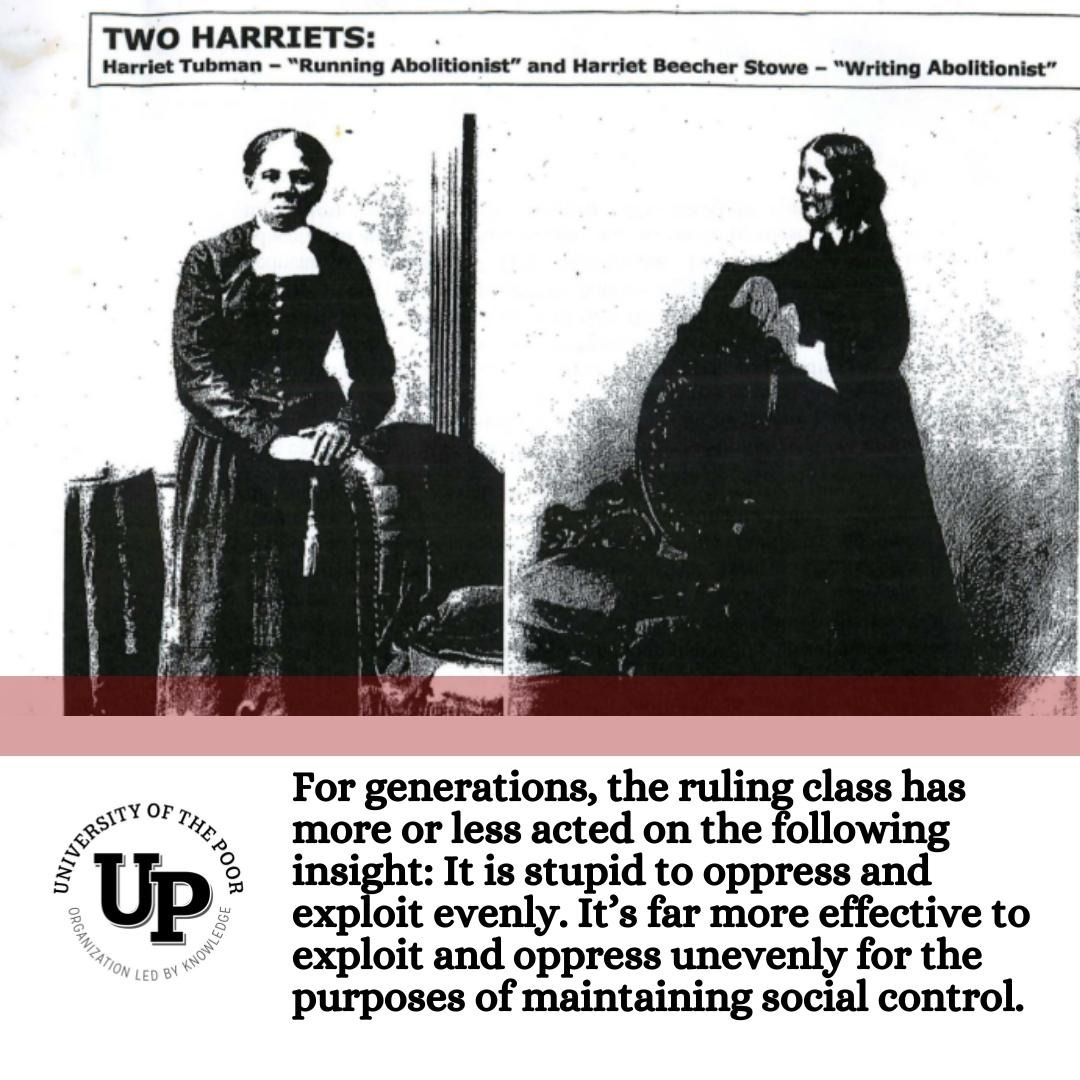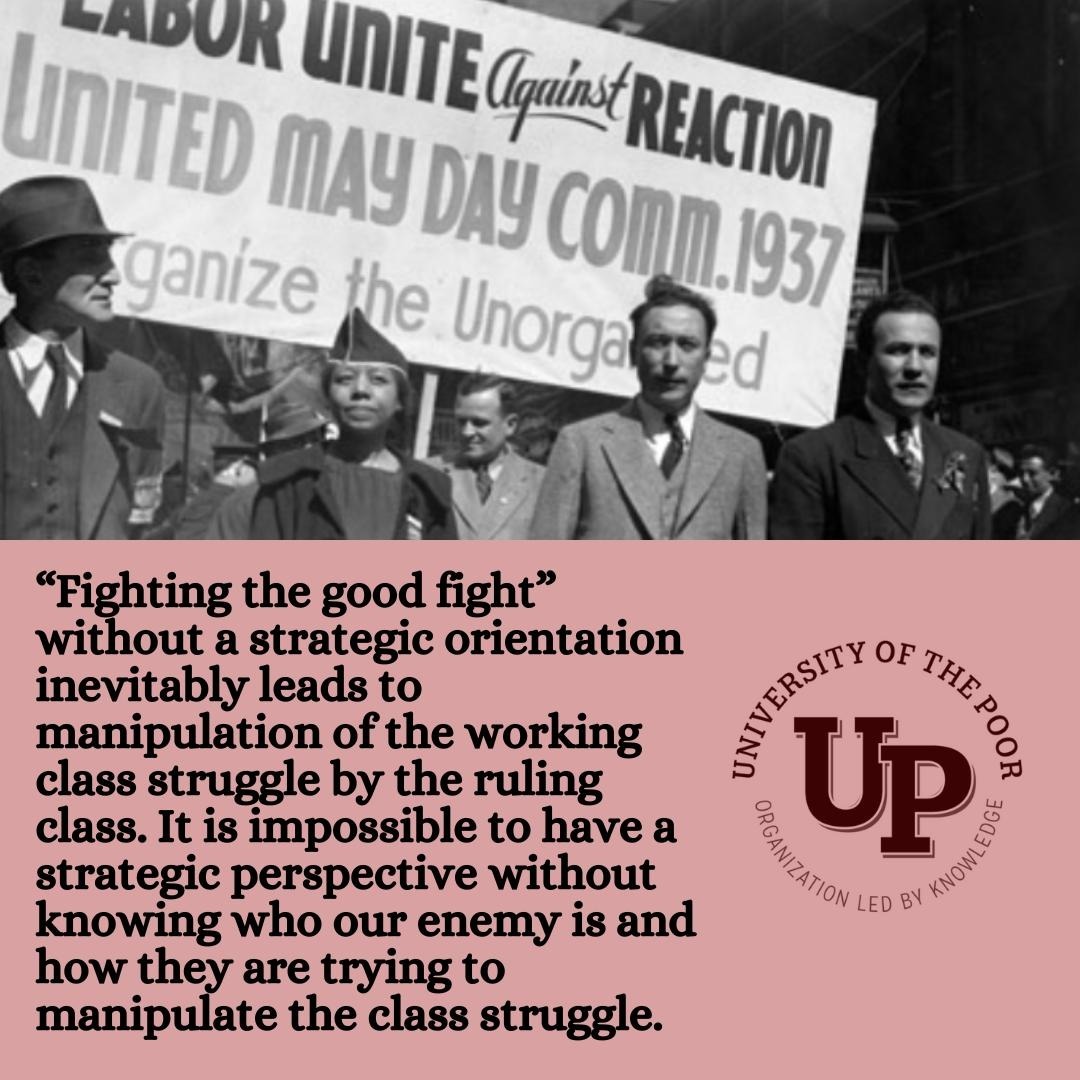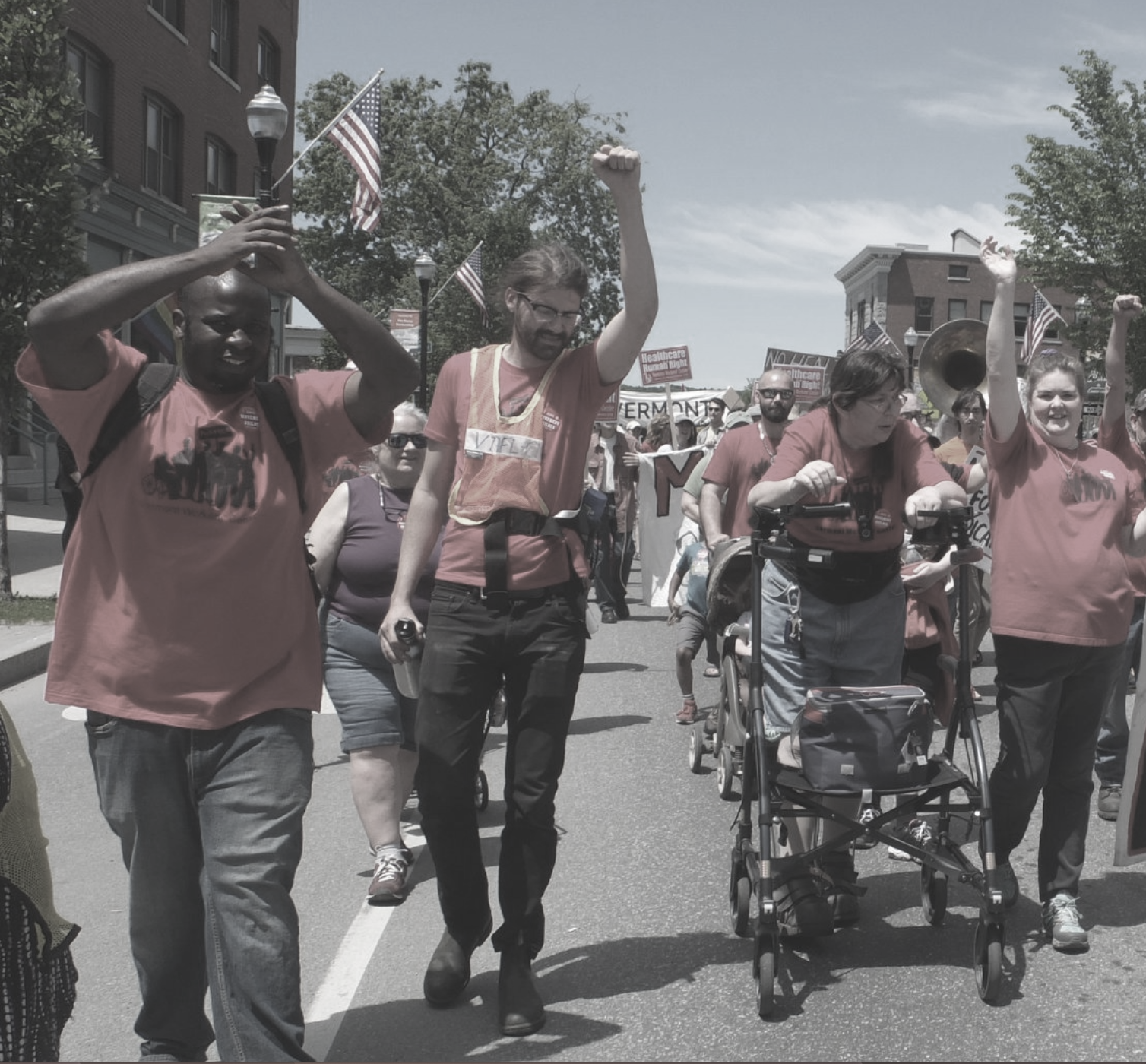By the University of the Poor History and Political Strategy Group
This excerpt comes from a working document entitled “Notes on Major Lessons from the Movement to End Slavery,” reflecting our collective study of the history of Abolition and Reconstruction over more than a decade. Originally it was developed within the context of the Poverty Scholars Program, the cornerstone program of the Poverty Initiative. As the University of the Poor History and Political Strategy Group has continued the study of this period, we have adopted this document and elaborated on it to sum up the many lessons we have learned in the process. It has been revised over time and is intended as a summation of the core lessons we continue to draw from this important area of study.
Introduction
The colonial settlement of North America, which laid the foundation for the United States of America, began with the murderous process to remove Indigenous peoples from the land alongside the brutal establishment of an economic system built on the labor of enslaved African peoples to produce commodities for world trade (i.e. tobacco, sugar, cotton). The relationship between land, labor, and capital which laid the foundation for capitalism in the United States set into motion a particular development of class rule. What emerged was a dictatorship of owners of property (i.e. capitalists) over the majority of propertyless people who either were held in a condition of chattel slavery or were compelled to sell their labor power to survive. Despite all claims of democracy, the history of the United States has by and large followed the “Golden Rule” – whoever has the gold gets to rule. This dictatorship of capital – of property ruling over the propertyless – has been reproduced through the evolving use of racialized divide and conquer strategy – what we call racism. For generations, the ruling class has more or less acted on the following insight: It is stupid to oppress and exploit evenly. It’s far more effective to exploit and oppress unevenly for the purposes of maintaining social control.
As long as there has been racialized slavery and genocidal settler colonial occupation, there has been resistance against the exploitation and expropriation at the heart of that system. To be clear, enslaved Black workers were at the center of that resistance. At the same time, this story connects to the resistance of other social forces, from the Seminoles in Florida to German immigrants in Missouri to the Mexican people facing U.S. conquest to poor non-slaveholding whites in Mississippi. The movement to end slavery began with enslaved people rebelling against the conditions under which they existed. There were countless rebellions and uprisings not to mention the daily forms of resistance – collective and individual – from the earliest days of the colonization of North America.
Furthermore, the historical development of slavery in what would become the United States of America occurred within an international context, relating to struggles in the Caribbean, Latin America, and beyond. For example, no study of abolition in the U.S. context is complete without grasping the impact of the Haitian Revolution. In fact, slavery was a primary engine in the development of international industrial capitalism. We must see the global connections between plantations and the development of Wall Street, the textile mills of Manchester, and beyond.
The period spanning 1830 through 1876 marks a historical period that featured the rise of a highly organized Abolitionist / Anti-slavery Movement, the polarization of every institution and segment of US society, the bloody conflict of a Civil War resulting in the expropriation of $4 billion worth of property in the emancipation of enslaved Black workers, the potentially revolutionary period of Reconstruction and the ultimate betrayal and defeat of Reconstruction – what Du Bois called the counterrevolution of property.
It is critical to recognize that all movements – revolutionary and reform alike – occur in stages. The building of a broad and powerful movement to abolish slavery developed, like all other successful social movements in history, through definite stages. The practice of thinking in terms of stages helps us determine what time it is now and what is to be done going forward. To this point, there are a couple of sayings to keep in mind: “Politics are the art of the possible.” And “a baby must crawl before she can walk.”
Thinking in terms of stages is not a mechanical, pre-ordained sort of thing. Furthermore, we can’t just lift the stages of an earlier movement and superimpose them on our situation today. Nevertheless, by examining the development of movement stages in history, we can draw lessons about correlations of forces, the relationship between cadre development and mass organization, and critical questions about the relationship between conditions and consciousness. For example, to quote Willie Baptist: “At least half of political strategy is political economy.” In other words, if we don’t try to understand the productive forces and relations at a given moment, we are not rooting our political strategy in the material reality of a society. Movement stages must be understood within this deeper political economic context. We have identified five stages as a way to understand the arc of the movement to end slavery.
Setting the Stage: “Rebellions and Uprisings”
Our main focus in this study is roughly fifty years inside the nineteenth century (1830-1877), but it is necessary to bring that period in relation to what came before. Within the context of North America – speaking in terms of the land that would become the United States of America – over the course of more than two centuries leading up to this period, people repeatedly joined together in rebellions, uprisings, and other forms of resistance to coerced labor. Knowing that prehistory is critical to understanding the conditions and consciousness of the historical bloc ranging from 1830-1877. We refer to this long stretch of time as “Rebellions and Uprisings”.
Our approach to “Rebellions and Uprisings” starts with the history around what is known as Bacon’s Rebellion and the other early joint African-descendant/ European-descendant uprisings as the beginnings of this stage. In the early development of the Virginia colony, and elsewhere, there were many examples of resistance to coerced labor and landlessness among people of African and European origin. The reason Bacon’s Rebellion in 1676 was a pivotal event was not because it was the best organized, strategic, or morally correct rebellion, but because it marked a turning point in the nature of the ruling class response to the threat of this type of rebellion. The ruling class inaugurated what Pem Buck describes as one hundred years of brutal mass public education to divide the bottom in order to maintain social control. Class struggle all the way up to our present moment bears a significant relation to this set of events.
At the same time, an account of this history is not complete without also grasping the brutal assault on Indigenous people – the mass murder of Indigenous people and the theft of their land. Whether we are studying the particulars of Bacon’s Rebellion or the broad sweep of European and eventual U.S. conquest of Indigenous lands, we must also try to see from the point of view of the Powhatans and other Indigenous nations as well as the African and European peoples. Bacon’s Rebellion is not a straightforward morality tale of heroic multi-racial unity from below. And still it provides a critical insight into the key social forces that would define class struggle going forward – the property holding planters and merchants, the enslaved Black workers, the landless but “free” poor white workers, and the Indigenous peoples. From the latter half of the 1600’s onwards, there was a century-long implementation of racialized chattel slavery and the invention of the white race – along with westward invasion of native lands. This bloody education (teaching the “value of whiteness”) was the first counter-revolutionary measure by the Slave Power.
This long history before 1830 is defined by frequent mass uprisings. From the Stono Rebellion to Nat Turner, there is evidence of spontaneous and organized forms of rebellion to the brutal conditions of slavery. One important point to raise here is that strategies give rise to counter-strategies between classes in conflict. The process of class struggle in the form of slave rebellions gave rise to an expansion of state power for the brutal repression of insurrections. The expansion of police, militia, slave patrols, and severe laws prohibiting the independent self-organization of enslaved Black workers, not to mention any unity across color lines (literacy laws, laws prohibiting unsupervised congregation, censorship of abolitionist press, incarceration of free Black sailors in southern ports, etc.) meant that enslaved Black workers and other social forces opposed to slavery had to take up new forms of resistance. It is quite significant that among new laws passed in the wake of Denmark Vesey’s plot and Nat Turner’s rebellion, enslavers made it illegal to teach enslaved Black workers to read and prohibited self-organized and unsupervised churches.
In addition to uprisings and rebellions, there were earlier attempts at abolition in the form of manumission, gradualism, and colonization. Certain religious denominations explicitly condemned slavery and there were earlier waves of political organizing in opposition to slavery. Nevertheless virtually all of these earlier expressions of abolition tended to be disconnected from the enslaved Black workers themselves. In most cases, they were co-opted and turned towards serving as loyal opposition.
In teaching this history to fellow cadre, no treatment of this history makes sense without grounding it in the history of rebellions and uprisings. Without setting the stage correctly, there is a danger in losing track from the outset of the very tip of the spear – the revolutionary social force. This struggle begins with those who would be free striking the first blow, and it is ultimately triumphant when enslaved Black workers, engaging in the General Strike, take matters into their own hands. With this grounding, we can turn to the period spanning 1830 through 1876. We argue that this period deserves our careful study because there emerged the formation, rise, fruition, and counter-revolution against a powerful revolutionary social movement – a multi-racial movement of abolitionists (and other anti-slavery forces). Tracing this movement over the ensuing decades reveals lessons in cadre and mass organization. It culminated in the defeat of the Slave Power and the end of slavery, and made possible Reconstruction.
First Stage (1830’s): “Moral Suasion” – Part of what defined this moment was the growing ranks of cadre organized around the common demands of 1.) Immediate abolition of slavery without compensation to the slaveholder; 2.) Equality of rights across racial lines. The formation and rapid growth of the American Anti-Slavery Society, along with various regional anti-slavery organizations from New England to the Midwest, marks this period. These societies, along with their abolitionist press, had characteristics of cadre organizations. Abolitionists in this moment took an uncompromising stand on slavery, the rejection of colonization schemes, and the affirmation that Black people were entitled to the right to “Life, Liberty, & the Pursuit of Happiness.” Moral language and appeals to religious values were critical elements during this stage. The main work at this stage of development was to accomplish the education, training, and uniting of leaders who embodied what we call the 4C’s: ideologically committed, theoretically/analytically clear, politically competent, and organizationally connected. No movement can advance without completing this first stage of identifying and uniting cadre around a core strategic vision. The practical work of the Underground Railroad and Vigilance Committees (“the running abolitionists”) accelerated at the same time and in close relationship to the explosion of the Abolitionist press (“the writing abolitionists”) engaged in a literary offensive. This combination of running and writing abolitionists gives substance to the expression: “Movements begin with the telling of untold stories.”
In the “Moral Suasion” stage, we see the relationship between the projects of survival/ the movement of the Underground Railroad and the furnishing of leaders of the Abolitionist movement with formerly enslaved Black workers: the struggle is a school, and officers/ generals of the movement were coming up from the ranks of the struggle. The Underground Railroad was one way cadres were becoming inseparably connected to the mass struggle/ the leading social force (and were being developed from the ranks of that social force). The Vigilance Committees played an important role within the Underground Railroad, as they represented the Underground Railroad in its most highly disciplined and organized form. In addition to providing material aid to fugitives, these committees acted as a conveyor belt of the knowledge of “slavery as it is” and leadership development, bringing hundreds if not thousands of fugitive slaves into the strategic and tactical leadership of the movement as writers, preachers, lecturers, militia organizers, and political leaders.
Moral suasion marked a break with the reformism of the movement prior to this point with the critique of gradual manumission and colonization (represented by the influential American Colonization Society). From the 1830s onwards, we can trace the fusing of revolutionary strands of abolitionism. Likewise, from this point onward, the emerging political independence of the movement grew in strength.
No account of this developing movement is adequate without reckoning with what we call the “Battle for the Bible.” The role of religion is a critical factor in the consciousness of the abolitionists movement. The Slave Power dominated state power, political parties, and an array of institutions including pulpits. Under these circumstances, the convictions that there was a law higher than man, and that slavery was not willed and justified by God, were critical aspects of the abolitionist movement and the Black church. The battle for the Bible comes into sharp focus during this moral suasion period, providing the abolitionists a moral basis to break independently politically.
Second Stage (1840s-1860): “Political Abolition”–As the movement grew, questions emerged around political agitation and mass organization. What is the movement’s relationship to electoral politics? How does cadre deal with questions of principle and compromise? As the King Cotton / the Slave Power continued to dominate politics and state power over the whole country, different sections of society found themselves in contradiction with these slaveholders.
There were a range of reasons for people to oppose the expansion of the system of slavery, and these contradictions were both economic and moral in nature. Over this period, there was the destruction of the then prevailing two party system of Democratic and Whig Parties, both controlled by the Slave Power, and the formation of independent political parties such as the Liberty Party, Free Soil & Free Labor Party, and the Republican Party. Every institution in society – church and state – polarized over the question of slavery.
During the preceding moral suasion stage, abolitionists had crafted a frame identifying the Slave Power as the enemy. This frame grew in popularity during the Political Abolition phase, as more sections of society found themselves in antagonistic relationships to the Slave Power. The electoral arena was the vehicle for an alignment of various social forces, from an economic struggle of enslaved black workers against their masters to a political struggle of all social forces that were blocked by the Slave Power’s hold on the federal government, i.e. its domination over state power. Political Abolition represented the fusing of moral and material interests of these various social forces, the experimentation of the early electoral parties, and the ultimately electoral victory of the Republican Party.
Third Stage (1861-1865): The Civil War–Slavery was the cause of the Civil War. Marx very accurately referred to the US Civil War as the “Slaveholders’ Rebellion.” The decisive factor that determined the outcome of the Civil War was what Du Bois called the “General Strike” of the Black Worker. Of four million enslaved Black workers, one million withdrew their labor, hundreds of thousands of them in turn taking up arms to fight for emancipation. A four year long war, resulting in roughly one million casualties, ultimately led to the military defeat of the slaveholders (the Slave Power) and economic confiscation of major capital investments – legally protected property in human beings. Emancipating the enslaved population meant the confiscation of an estimated total $4 billion in capital. No expropriation of private property would compare in sheer scale to the ending of slavery in the United States until the Bolshevik Revolution in the Russian Empire. The Slave Power – the most powerful section of the capitalist ruling class in the United State – was at that moment defeated.
Fourth Stage (1865-1876): Reconstruction-The political defeat of the former slaveholding planter, i.e. the Slave Power led to the establishment of one of the freest democratic republican governments in history. Contrary to the lies perpetuated for generations, Reconstruction represented a moment of great revolutionary potential. A prime example to study here is what Du Bois called “The Dictatorship of the Black Worker” in South Carolina. Du Bois called Black political power in cooperation with some sections of poor whites in the South “one of the most extraordinary experiments of Marxism that the world, before the Russian revolution, had seen…. a dictatorship of labor.” Du Bois wrote: “[Radical Reconstruction] was a test of the whole theory of American government. It was a dictatorship backed by the military arm of the United States by which the governments of the Southern states were to be coerced into accepting a new form of administration, in which the freedmen and the poor whites were to hold the overwhelming balance of political power. As soon as political power was successfully delivered into the hands of these elements, the Federal government was to withdraw and full democracy ensue.” The program of Reconstruction based on “Land, Light, & Leading” – in other words, the right to land redistribution, education, and a government in the interest of the vast majority of poor Black and poor white workers in the South – was the North Star. While the “Kingdom of God” was not realized on earth, the program of Reconstruction achieved far more than has been widely understood.
Fifth Stage (1876): Defeat of Reconstruction-The Tilden-Hayes Compromise marked the ultimate betrayal and defeat of the revolutionary slogan “40 acres and a Mule.” It reduced both the Black and poor white masses to semi-slavery to work the fields of the still very profitable “Black Belt” placed back into the hands of “King Cotton” – the southern agrarian capitalists. However, this new system ultimately placed Wall Street in control. This counter-revolution of property led to the rise of economic and political dominance of the industrial robber barons and Wall Street. The local ruling class became a subordinate group in relation to the super-capital of railroads, industry, and banking. The southern economic and political leadership became junior partners in the larger project of capitalist exploitation and accumulation, and were left to implement a new racial caste system – Jim Crow – in the name of “home rule.” The US South became a sort of colony inside the boundaries of the United States. From this point on, in the words of Du Bois, the South controlled the nation and Wall Street controlled the South. Its position of dominance over the South and rest of the country enabled Wall Street to project an imperialist agenda around the world.The South, under the new regime of Jim Crow, became a base of political and social reaction, and a political and economic reserve built on disfranchisement of the masses for the benefit of property.
Conclusion
General Baker liked to say, “History is the rock we stand on, and if you are not on the rock, you’re on sand that will get swept right out from under you.” From where we stand today, we have choices on what part of the past we study. So why study this particular history? In our work to build a broad social movement committed to ending poverty, we are looking for economic and political parallels in the history of the United States and beyond that will best inform the concrete tasks today. Our working hypothesis is as follows: the struggle to abolish poverty today has more to learn from the movement to abolish slavery than from the 1930s’ Labor Movement and 1960s’ Civil Rights Movement. To be clear, there is much to learn from a deep study of all past US mass movements including the struggles of the1930s and 1960s. It does not serve us to dismiss the courageous struggles of all the generations of freedom fighters who came before us. However, it is our assessment that the Anti-Slavery / Civil War / Reconstruction movement brought about a shift in economic and political power relations, while the Civil Rights Movement and Industrial Labor Movement were limited to achieving concessions from the existing power relations. Also the Anti-Slavery / Civil War / Reconstruction movement took place against the backdrop of the first Industrial Revolution, which perhaps provides some parallels to the social and political struggles today and the current Electronic/Information Revolution. The study of Abolition, Civil War, and Reconstruction can provide us with a set of historical parallels that will take our thinking further on questions of movements of reform versus revolution, as well as questions of counter-revolution and knowing our enemy. Above all, it teaches us to focus on the question: Who is the revolutionary social force? Are we waking up everyday thinking about who this force is and how it can be helped to take action to become a “new and unsettling force”? Studying this history helps us understand better the history that has unfolded in the United States up to our present moment, and ultimately it lays the basis for our studying the revolutionary processes of the poor and dispossessed internationally.




[…] History and Political Strategy Team of the UPoor argues that mastering an understanding of the Movement to End Slavery is crucial for revolutionaries in this period. Even more than the heroic struggles of the 1930s and 1960s, which achieved […]